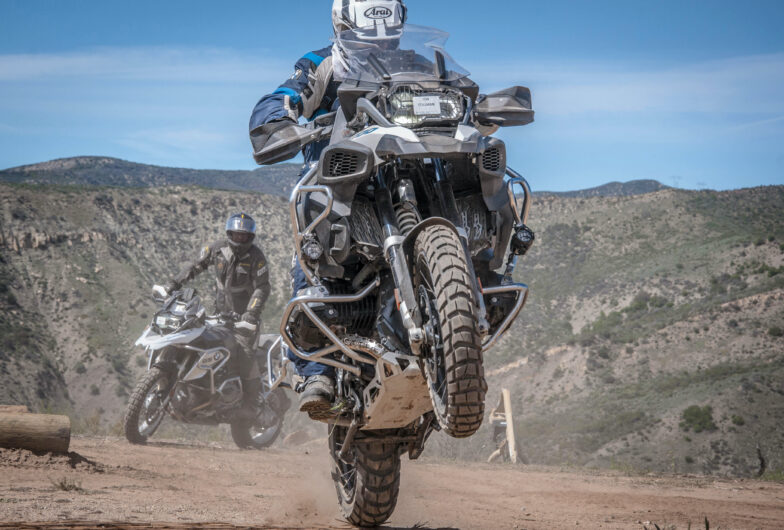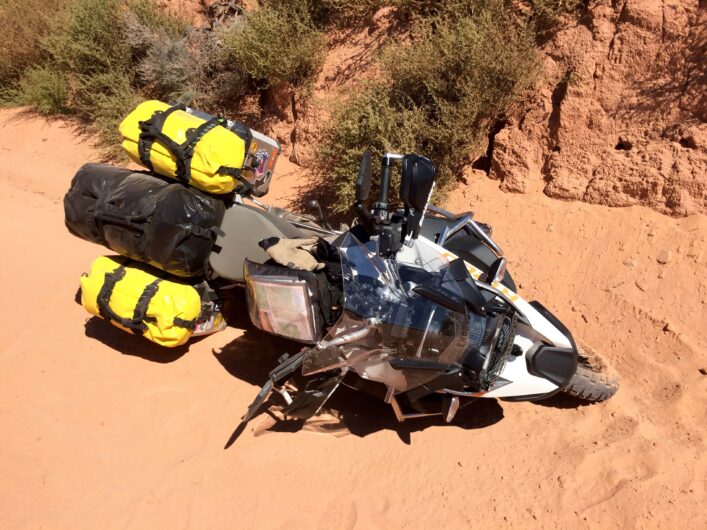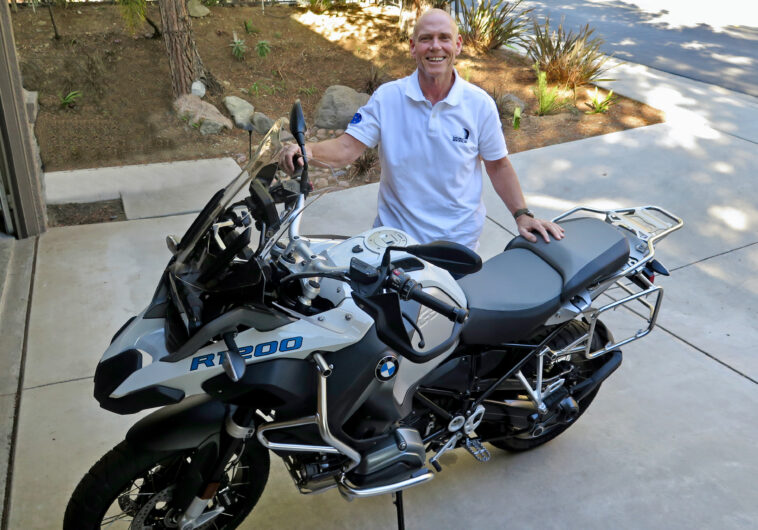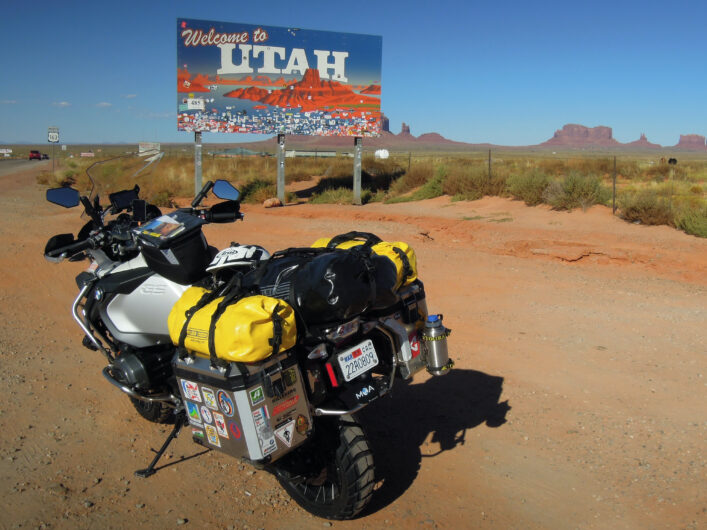We all carry a satellite communicator device when we ride into the backcountry (you do carry a satellite communicator, don’t you?). They are the only way to send a message when you ride out of cell service range and are also a great way for friends to keep track of your location. But the main reason we carry the device is the feature that we seldom, if ever, have to use. That’s the SOS button.
A UNIVERSAL CALL FOR HELP
Today, SOS is recognized universally as a distress signal that can be sent from some cellphones (but not many) or a satellite communicator device (if you have a view of the sky). If you want to know the mechanics of what happens when you hit the SOS button, go to your device’s operating manual. This article looks at what happens on the ground when that button is pushed and the troops are scrambled.
I’ve only heard second-hand, antidotal SOS stories that were impossible to verify. That all changed when I caught up with Jon Stillman. Jon’s motorcycling career is deserving of a book. Jon raced motocross and enduro events for a US Army sanctioned motorcycle club. The progressive 4-Star General who approved the club did it on the condition that American-made motorcycles be raced. The club chose, not Harley-Davidsons, but Rokons (Motocross Action Magazine has a great story on the Rokon that you can read by clicking here). Instead of reenlisting, Jon went to work for Rokon. He later was the American importer of Ohlins suspension and worked first at Husqvarna and then had a 27-year career at Honda where he retired. He is an expert-level rider both on and off road and has coached new and experienced riders. He’s the real deal.
A CHANGE IN ROUTES
You need a little background on what led up to the SOS moment. Jon was 5 days into a 20 day solo ride so he was carrying a lot of gear. He encountered a newly-graded silt road near Green River, Utah. “It was just the worst surface,” remembers Jon. “It was soft and deep silt. The grading created a crown or peak in the middle of the road that continually forced me to the road’s edge where soft berms had formed. I must have tipped over 5 times in 5 miles.”
Jon decided to change course and head towards the rocky roads of Colorado instead of continuing to Moab, Utah. “The rocks would be a lot better than riding more miles of silt,” explains Jon. He admits that he was cruising around 40 miles per hour and seated when he came up on a blind turn. Unfortunately, a washout caught Jon by surprise. “I had already tipped over enough so I thought maybe I could save it by putting my leg out,” remembers Jon. Didn’t work. He not only fell, he knew instantly that his leg was broken.
PUSHING THE SOS BUTTON
Jon, most likely in shock and in more than a little pain, checks his phone and it has one bar of reception. He calls a buddy in Phoenix and asks him to come pick him up! His buddy hears Jon’s predicament and tells him to hang up and push the SOS button on his Garmin InReach Explorer. Jon did just that.
He dealt with the pain for the next 20 minutes when his phone rang. It was his wife! She asked her husband what was going on because she had just gotten a call from an emergency operator who said Jon’s SOS signal had gone off and wondered if she knew anything about his condition (Jon’s wife is listed as the in-case-of-emergency contact). She told the operator in no uncertain terms, “look, my husband is an experienced rider. If he sent out that signal, it is not a mistake. He needs help.” Jon always thought HE was supposed to be contacted through his Garmin InReach Explorer by the rescue team. To his knowledge, that never happened. Luckily for him, his wife handled the situation perfectly and help was dispatched.
Jon waited approximately 20 more minutes (so now we’re up to 40 minutes since the crash) before the first rescue vehicle arrived. It was a Sheriff who, seeing Jon’s condition, radioed for an ambulance. The ambulance’s arrival was another 30 minutes away. They cut off Jon’s boot and administered what Jon assumes was morphine. Pain under control, they got him on the stretcher and started to load him for transportation to a hospital in Grand Junction, Colorado (over two-hours away).
While being loaded into the ambulance, Jon, who now is feeling no pain, asks, “What about my bike?” The sheriff said he’d call a tow truck. Jon objected and explained the bike would need a flatbed truck for transport. Jon got the name of the towing company with assurances that the storage fee wouldn’t be more than $5 a day. For a guy with a severely broken leg, Jon held it together better than most of us would have.
THE AFTERMATH
Jon’s leg was indeed broken and needed a titanium rod. He was fortunate that Grand Junction had a good surgeon. After the leg healed, Jon continued his motorcycling although he never planned another solo adventure. Today, he has sold all his motorcycles and now rides bicycles (road, mountain and gravel) full time. “I still carry a satellite communicator on my bicycle rides,” explains Jon. “The phone will have cell service one mile and no service the next mile.”

LESSONS FROM THE SCHOOL OF HARD KNOCKS
1. Never go on a backcountry ride without a satellite communicator device. The units will set you back between $150 to $300 and there is a monthly fee in the $20 neighborhood. Well worth the peace of mind.
2. Carry the device on your person in an easy-to-reach location. Do not stow it on your motorcycle or inside a hydration pack. You must be able to reach it if you are in need.
3. Try to buddy up for backcountry adventures. The attraction of going it alone is understandable but weigh the risks and ride accordingly.
4. Be sure that your in-case-of-emergency contact knows your plans and knows how to respond. And pick someone who won’t panic.
5. If you ride pavement to a backcountry (dirt) route, remember to reduce your tire air pressure once you hit dirt.
6. Don’t carry excessive fuel. You probably won’t need 400 miles of range. That much fuel makes the bike top heavy and more difficult to handle.
7. Get out of the saddle when you have limited visibility. Riders have much better control, balance and feeling through their feet than through their butts.





